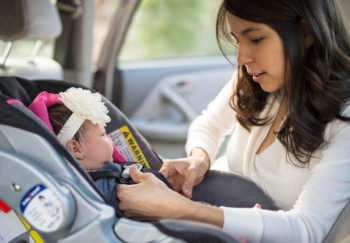
You may wax nostalgic about childhood road trips doing somersaults in the back of your family’s wood-paneled wagon. But in the words of Maya Angelou: “When you know better, you do better.”
Fortunately, for our kids’ sakes, we do know better. We know motor vehicle accidents are the number one cause of death among children and adolescents. And we also know that car seats for kids can reduce injuries and deaths by as much as 70 percent when they’re used correctly.
This is why registered nurse Sherri Ferraro has made it her mission to help educate others on the right way to buckle up little passengers. “I have been a certified child passenger safety technician since 2003,” she says. “I got my certification after working in the ER and seeing so many kids come in who had not been strapped in properly.”
With the variety of car seats for kids available and recent changes to Virginia’s child restraint laws, there’s no doubt parents could use a bit of guidance. We asked Ferraro to help set the record straight on the best ways to keep kids safe on the road.
Car Seat Safety: Tips from a Child Passenger Safety Technician
What was the most notable change to Virginia’s Child Restraint Device Law?
The new law, which took effect July 1, states that infants should remain in a rear-facing car seat until the age of 2 or until the child meets the recommended minimum height and weight requirement specified by the seat manufacturer. I would recommend parents purchase a convertible seat that can be rear facing and that has a higher weight and height limit. It can then be turned forward-facing once the child has reached age 2. Keeping a child rear-facing until age 2 is safest for them.
When babies are forward-facing in a collision, their heads snap forward quickly. The head is the largest part of their body, and their musculature and bone structure aren’t strong enough to hold it in place. So babies can suffer severe head injuries or even a broken neck.
What are some of the most common mistakes parents make when buckling kids in?
One is not strapping kids in properly. If straps aren’t positioned properly or secure enough, kids can be ejected. You shouldn’t be able to pinch any of the webbing once the strap is tightened.
Also, if you put a child in the seat and strap them in with a big fluffy coat, during a crash, that coat will compress. This puts more space between the child and their seat belt, so they may be ejected. If it’s cold out, use a blanket or put a coat on your child backwards after they’re strapped in.
Not securing the seat properly is another common mistake. The base shouldn’t move back and forth or sideways more than an inch once it’s installed. You always want to look at the owner’s manual for your car and read the instructions on the car seat. There’s a lot of good information there.
Are accessories like headrests safe to add to a car seat?
The general rule is that if it doesn’t come with the seat, it’s not safe. Even though a product may say it’s been tested and is safe to use, keep in mind that it’s been tested by itself, but not with your seat. If your baby needs added head support, try rolling up a receiving blanket and tucking it alongside their head.
Is Your Car Seat Safe?
Find a free local car seat safety check location near you.
When can a child transition out of a booster seat?
Children are required to use a booster seat until age 8, but really it depends on the child. Kids come in different sizes. If your child’s legs don’t bend at the knee and touch the floor with his bum against the back of the seat, or if the seatbelt isn’t positioned properly across his lap and shoulder, then he isn’t big enough to ride without a booster.
What advice do you have for parents whose older kids covet the front seat?
The back seat is the safest spot for kids. But if they’re going to move up front, they should wait until they’re at least 12 years old.
Are there any resources you can recommend for parents who want to do a car seat safety check?
A lot of local fire departments and police stations have Child Safety Passenger Technicians. Call ahead to make an appointment.

Thank you a lot for providing individuals with remarkably wonderful possiblity to read articles and blog posts from this website. It can be very pleasurable and also stuffed with fun for me and my office friends to visit your blog nearly three times in a week to see the fresh items you have. And lastly, we’re always happy considering the unique hints served by you. Some 2 areas on this page are undoubtedly the best I have ever had.